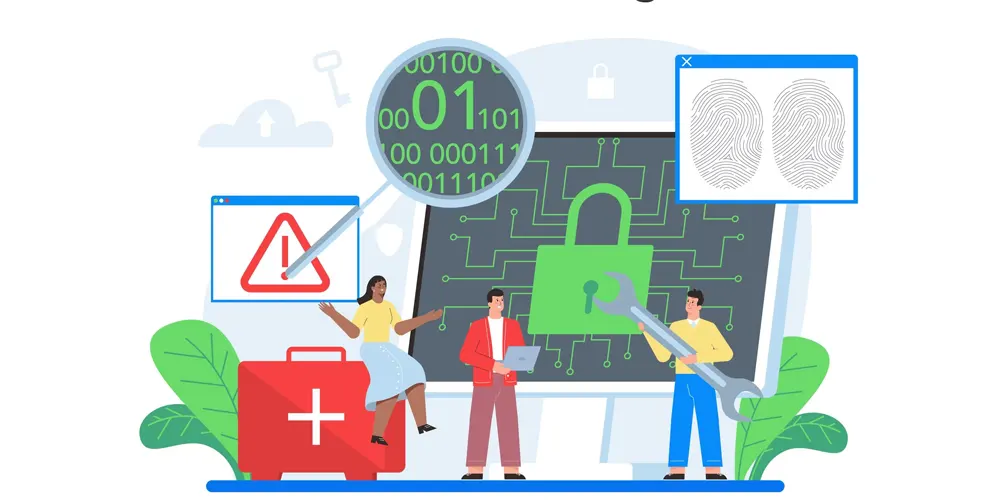10 Factors to Consider While Choosing a Webphone
Unless you’ve been living under a rock, you already know the multitude of benefits web phones have to offer to businesses. They have a lot of features that improve various business functions in terms of efficiency and effectiveness.
Now that you’re convinced, the next question that you have to face is which webphone should you invest in for your business. There’s no one answer to it as web phones come in different shapes, and forms and are loaded with varying features.
So the question now changes to what all things should you consider while choosing a webphone? Thankfully, you won't have to wonder much as we have the list compiled for you.
We shall go through 10 important factors in this blog that you need to consider while choosing a webphone for your business.
Let’s dive into the list then, shall we?
1. Compatibility

Businesses run on the foundation of a strong tech stack. One needs to ensure every technology works well together when you're using technology so intensively for business operations.
Compatibility refers to the ability of the web phone to integrate with the existing communication systems in the organization.
Choosing a web phone that is compatible with existing systems ensures effective and smooth communication and increased productivity. Therefore, compatibility with the existing tech stack becomes a vital factor when choosing a web phone.
For example, a business that uses Microsoft Teams for internal communication should choose a web phone that integrates seamlessly with it. This allows employees to make and receive calls directly from Teams.
2. Call Quality

Imagine you’re in the middle of negotiating the most important business deal and the audio starts breaking and the video is glitchy. Would be infuriating right?
Call quality, thus, becomes an important factor to consider when choosing a webphone. High-quality voice and video calls are essential for effective communication.
Factors such as network connectivity, microphone quality, and speaker quality can impact call quality. Therefore, businesses must choose a web phone that delivers exceptional call quality to ensure that communication is effective and productive.
For example, the Jabra Speak 710 is a portable speakerphone that delivers exceptional sound quality for conference calls. It has a 360-degree microphone that captures sound from all directions and an omnidirectional speaker that provides clear audio.
Choosing a web phone with excellent call quality can also help businesses save time and money. With communication being effective, you would require fewer follow-up calls. This will ensure higher work efficiency and conservation of business resources.
3. User Interface

You might have the best and most feature-loaded webphone on the market. However, if any regular employee isn't able to use all of its capabilities properly, what’s the use?
Thus, the next factor to consider while choosing a webphone is its user interface. A user-friendly interface ensures that employees can easily use the web phone. This reduces the learning curve and increases their productivity.
Businesses must choose a web phone with an intuitive interface that's easy to navigate, and that doesn't require extensive training.
The user interface should also be visually appealing and provide easy access to essential features, such as call logs, contacts, and voicemail.
For example, the Grandstream GXP2170 is a web phone with a user-friendly interface. It allows for quick and easy access to essential features.
It has a large colour display that shows call information, contacts, and other relevant data. The interface is intuitive and easy to navigate, making it ideal for businesses that require a web phone that's easy to use.
4. Security

Cybercriminals have been a menace to businesses in recent years. Big multinationals are no longer their only targets. Cybercriminals have become indiscriminate and pose a threat to small and medium businesses equally today.
Thus, the level of security that a webphone offers is another important aspect you need to pay attention to. Web phones can be vulnerable to cyber-attacks. Choosing a device with robust security features is essential to protecting your business
Businesses must choose a web phone with encryption capabilities that can secure voice and video calls and prevent eavesdropping.
The device should also have features such as secure boot, firmware verification, and password protection to prevent unauthorized access.
For example, the Yealink T58A is a web phone with built-in security features that protect against cyber threats. It has secure boot, firmware verification, and password protection to prevent unauthorized access to the device. It also has encryption capabilities that secure voice and video calls, ensuring that sensitive data is protected.
Choosing a web phone with robust security features can also help businesses comply with regulations such as HIPAA and GDPR. This ensures that the organization avoids costly fines and reputational damage.
5. Scalability

As the extended market goes through cyclical ups and downs, businesses have to scale their operations accordingly. Imagine that your business grows exponentially, you hire new people only to find out that your webphone system’s capacity is already maxed out.
Or let’s say your business takes a big hit, and you downsize operation only to find out that you have to keep paying for your webphone system’s now excess capacity.
Either scenario spells trouble for businesses. Thus, scalability is another top factor that you need to consider when choosing a webphone system.
Businesses must choose a web phone that can scale easily to meet their changing communication needs.
The device should be able to integrate with other communication tools and platforms to ensure that communication is streamlined across the organization.
For example, the Cisco IP Phone 8800 Series is a web phone that can scale easily to meet the changing communication needs of businesses. It can integrate with Cisco's Unified Communications Manager platform as well.
6. Integration

The extent of API integrations available for a webphone is also an important factor that businesses need to consider.
API Integrations allow businesses to integrate their web phone with other communication tools and platforms. Examples include customer relationship management (CRM) software, to streamline communication and improve efficiency.
The device should have an open API that allows for easy integration with third-party applications. Thus businesses can customize the device to meet their specific communication needs.
For example, the RingCentral Phone is a web phone that offers plenty of API integrations. It can easily integrate with CRM tools such as Salesforce, Microsoft Dynamics, and Zendesk.
Choosing a web phone with robust API integrations can also help businesses automate communication workflows and improve collaboration. This ensures that communication is efficient and streamlined, reducing the risk of errors and improving productivity.
7. Cost

You might opt for the best webphone on the market. However, it won’t be a smart choice if it's going to cost you an arm and a leg for it. While communication is a crucial function for any business, you need to spend wisely for it.
The costs and pricing structure of the device should align with the business's budget and communication requirements. This ensures that the investment is worthwhile.
Businesses must choose a web phone that offers a pricing structure that is transparent and predictable. The device should provide clear pricing for the device, hardware, and software, including any additional fees or charges, such as maintenance or support.
For example, 3CX Phone System is a web phone that offers a flexible pricing structure. Businesses can choose a plan that aligns with their communication needs and budget. While yes, they were hacked recently, they have come out of it unscathed.
3CX provides pricing based on the number of users, and businesses can choose to pay monthly or annually, depending on their preference.
8. Customer Support

No matter how user-friendly a webphone is, you’re going to end up in trouble at some point. Now imagine how difficult things would get if you found out that your webphone vendor’s customer support hours do not overlap with your business hours.
You would be left waiting for hours if not days to get the required assistance to solve the problem. Such instances can cost your business dearly. Thus, customer support turns out to be another factor you need to consider before choosing a webphone system,
Businesses must choose a web phone that offers comprehensive customer support, including phone support, email support, live chat, and knowledge base resources.
The device's customer support should be easily accessible and available 24/7 to ensure that businesses can get assistance at any time.
For example, the Nextiva VoIP Phone System is a web phone that offers robust customer support.m This includes 24/7 phone support, email support, live chat, and a comprehensive knowledge base.
The device's customer support is highly rated. Their team of experts provide assistance with setup, troubleshooting, and optimization.
9. Reliability

For a crucial business function like communication, downtime is highly undesirable. So without wonder, the reliability of the webphone system is another crucial factor to consider.
For businesses, web phones that offer high uptimes and minimal downtimes are needed to ensure communication remains flawless and highly available.
The device should also provide excellent call quality, minimal call drops, and clear audio to ensure that communication is efficient and streamlined.
For example, RingCentral is a web phone that offers high reliability, with a 99.999% uptime guarantee. The device also offers advanced redundancy, automatic failover, and backup routing.
Choosing a reliable web phone can also help businesses save time and reduce costs. The device's reliability ensures that communication is seamless and uninterrupted. Thus reducing the need for troubleshooting and maintenance, which can be costly and time-consuming.
10. Customization

One size seldom fits all when it comes to business requirements. Thus, one needs to ensure that the webphone they opt for is flexible and customizable enough to accommodate their unique business requirements.
A good webphone system should offer a high degree of customization capability. This may include personalized greetings, call routing, and call handling rules.
The device should also allow customization of the user interface, enabling businesses to tailor the device to their specific needs.
For example, Vonage is a web phone that offers extensive customization options. Customizable greetings, call routing, call handling rules and UI options are among the many things that can be customized with it.
Choosing a customizable web phone can also help businesses improve their communication efficiency and productivity. The device's customization options enable businesses to create workflows and call-handling rules that meet their specific communication needs.
With that, we’re at the end of our list and we hope this was helpful!
Conclusion
Yes, there are a lot of things to consider when choosing a webphone for your business. It might seem overwhelming but it won't be if you go through one factor at a time.
Communication is an important function of any business. One needs to do everything in their power to improve this function while ensuring there are no cost overruns. Finding the right balance between spend and capabilities will be the key for you!
And remember, whatever fits the best with your business needs is what will drive progress for it.
Happy shopping and communicating!
























































































































